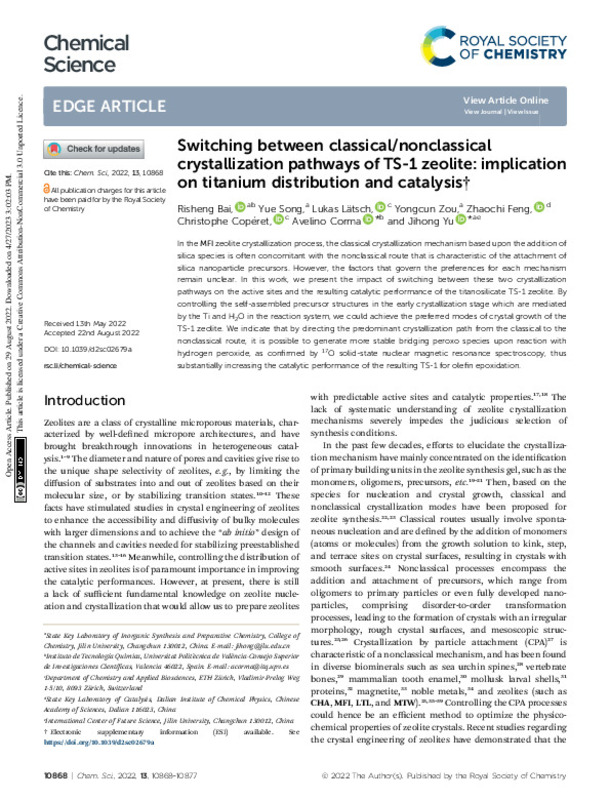JavaScript is disabled for your browser. Some features of this site may not work without it.
Buscar en RiuNet
Listar
Mi cuenta
Estadísticas
Ayuda RiuNet
Admin. UPV
Switching between classical/nonclassical crystallization pathways of TS-1 zeolite: implication on titanium distribution and catalysis
Mostrar el registro sencillo del ítem
Ficheros en el ítem
| dc.contributor.author | Bai, Risheng
|
es_ES |
| dc.contributor.author | Song, Yue
|
es_ES |
| dc.contributor.author | Latsch, Lukas
|
es_ES |
| dc.contributor.author | Zou, Yongcun
|
es_ES |
| dc.contributor.author | Feng, Zhaochi
|
es_ES |
| dc.contributor.author | Coperet, Christophe
|
es_ES |
| dc.contributor.author | Corma Canós, Avelino
|
es_ES |
| dc.contributor.author | Yu, Jihong
|
es_ES |
| dc.date.accessioned | 2023-07-14T18:01:03Z | |
| dc.date.available | 2023-07-14T18:01:03Z | |
| dc.date.issued | 2022-09-21 | es_ES |
| dc.identifier.issn | 2041-6520 | es_ES |
| dc.identifier.uri | http://hdl.handle.net/10251/194989 | |
| dc.description.abstract | [EN] In the MFI zeolite crystallization process, the classical crystallization mechanism based upon the addition of silica species is often concomitant with the nonclassical route that is characteristic of the attachment of silica nanoparticle precursors. However, the factors that govern the preferences for each mechanism remain unclear. In this work, we present the impact of switching between these two crystallization pathways on the active sites and the resulting catalytic performance of the titanosilicate TS-1 zeolite. By controlling the self-assembled precursor structures in the early crystallization stage which are mediated by the Ti and H2O in the reaction system, we could achieve the preferred modes of crystal growth of the TS-1 zeolite. We indicate that by directing the predominant crystallization path from the classical to the nonclassical route, it is possible to generate more stable bridging peroxo species upon reaction with hydrogen peroxide, as confirmed by O-17 solid-state nuclear magnetic resonance spectroscopy, thus substantially increasing the catalytic performance of the resulting TS-1 for olefin epoxidation. | es_ES |
| dc.description.sponsorship | The authors thank the National Key Research and Development Program of China (grant 2021YFA1501202), the National Natural Science Foundation of China (grant 21920102005, 21835002 and 21621001), the 111 Project (B17020), the European Union through the European Research Council (grant ERC-AdG-2014-671093, SynCatMatch), and the Spanish Government through "Severo Ochoa" (SEV-2016-0683, MINECO) for supporting this work. L. L. thanks the Scholarship Fund of the Swiss Chemical Industry (SSCI) for funding. Jos ' e Gaona Migu ' elez is acknowledged for his technical help. | es_ES |
| dc.language | Inglés | es_ES |
| dc.publisher | The Royal Society of Chemistry | es_ES |
| dc.relation.ispartof | Chemical Science | es_ES |
| dc.rights | Reconocimiento - No comercial (by-nc) | es_ES |
| dc.title | Switching between classical/nonclassical crystallization pathways of TS-1 zeolite: implication on titanium distribution and catalysis | es_ES |
| dc.type | Artículo | es_ES |
| dc.identifier.doi | 10.1039/d2sc02679a | es_ES |
| dc.relation.projectID | info:eu-repo/grantAgreement/EC/H2020/671093/EU | es_ES |
| dc.relation.projectID | info:eu-repo/grantAgreement/NSFC//21920102005/ | es_ES |
| dc.relation.projectID | info:eu-repo/grantAgreement/NSFC//21835002/ | es_ES |
| dc.relation.projectID | info:eu-repo/grantAgreement/NSFC//21621001/ | es_ES |
| dc.relation.projectID | info:eu-repo/grantAgreement/MINECO//SEV-2016-0683/ | es_ES |
| dc.relation.projectID | info:eu-repo/grantAgreement/MOE//B17020/ | es_ES |
| dc.relation.projectID | info:eu-repo/grantAgreement/NKRDPC//2021YFA1501202/ | es_ES |
| dc.rights.accessRights | Abierto | es_ES |
| dc.description.bibliographicCitation | Bai, R.; Song, Y.; Latsch, L.; Zou, Y.; Feng, Z.; Coperet, C.; Corma Canós, A.... (2022). Switching between classical/nonclassical crystallization pathways of TS-1 zeolite: implication on titanium distribution and catalysis. Chemical Science. 13(36):10868-10877. https://doi.org/10.1039/d2sc02679a | es_ES |
| dc.description.accrualMethod | S | es_ES |
| dc.relation.publisherversion | https://doi.org/10.1039/d2sc02679a | es_ES |
| dc.description.upvformatpinicio | 10868 | es_ES |
| dc.description.upvformatpfin | 10877 | es_ES |
| dc.type.version | info:eu-repo/semantics/publishedVersion | es_ES |
| dc.description.volume | 13 | es_ES |
| dc.description.issue | 36 | es_ES |
| dc.relation.pasarela | S\489967 | es_ES |
| dc.contributor.funder | European Commission | es_ES |
| dc.contributor.funder | Ministry of Education of China | es_ES |
| dc.contributor.funder | Swiss National Science Foundation | es_ES |
| dc.contributor.funder | National Natural Science Foundation of China | es_ES |
| dc.contributor.funder | Ministerio de Economía, Industria y Competitividad | es_ES |
| dc.contributor.funder | National Key Research and Development Program of China | es_ES |








